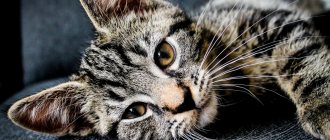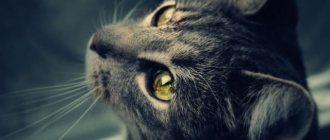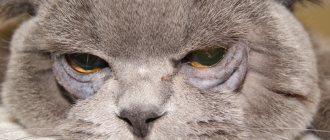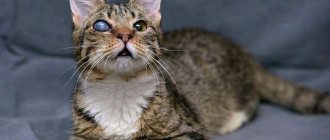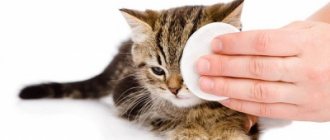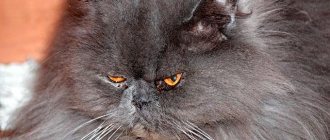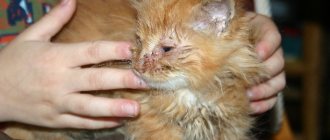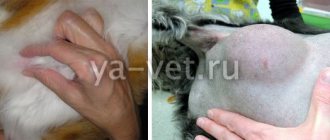Save the article:
In the structure of the cat's eye analyzer there is a translucent membrane called the third eyelid. In a healthy pet, this formation is noticeable only when blinking and half asleep. But in some cases, the fold at the inner corner of the eye swells and extends beyond the lower and upper eyelids. This situation in most cases is a consequence of serious causes and requires timely treatment.
A cat's third eyelid performs several important functions. It protects the cornea of the eye from irritating particles from the outside, distributes the secretion of the lacrimal gland over the surface of the eyeball, and protects the mucous membrane from drying out. If the membrane falls out and becomes noticeable when the cat's gaze is open, then this is a signal for alarm. The reasons for this phenomenon may be different.
Causes of third eyelid prolapse
global $ads_google;
//data-ad-slot=”2475549904″ $ads_google = empty($ads_google) ? false : true; ?> if ($ads_google == false) {?> $ads_google = true; ?> } ?> With a quick glance at the cat, it is difficult to immediately determine the cause of the swelling of the thin fold. It can be associated with both external influences and internal factors. Veterinarians name a lot of reasons for the loss of the third eyelid:
- Infection of a bacterial, fungal or viral nature;
- Impaired functioning of the liver, intestines, kidneys;
- Hormonal imbalance in the body;
- Severe exhaustion, dehydration of the body;
- Weakening of the ligaments and muscles of the eye;
- Inflammatory process in the auditory analyzer;
- Introduction of foreign bodies into the mucous membrane of the eye;
- Infection with parasitic worms;
- Mechanical damage to the eye area;
- Development of allergic conjunctivitis;
- Benign or malignant formation;
- Malnutrition of the eyeball (atrophy);
- Deformation of the elastic cartilage of the third eyelid;
- Eye size that is too small (microphthalmos).
Problems with the conjunctival fold can occur in cats of any breed, age, or gender. However, it has been noted that the Persians and the British are the most sensitive in this regard. Genetic predisposition increases the risk of third eyelid prolapse in cats of these breeds, regardless of the cause.
ON A NOTE
:
In rare cases, the nictitating membrane becomes noticeable in an animal after castration and under severe nervous stress.
Preventive measures
To protect the tailed creature and minimize the occurrence of problems with the visual apparatus, you should do the following:
- plan a cat’s diet - it must be balanced and consist of quality products;
- do not forget about additional vitamins in the cat’s menu;
- periodically rinse your cat's eyes with Furacilin (1 tablet per 100 g of water);
- use potassium permanganate for preventive purposes;
- regularly examine the eyes of the mustachioed creature and monitor changes in its behavior;
- do not forget to free your pet from roommates - worms, fleas, etc.
- Take your pet to the veterinary clinic for examinations at least once a year.
If you notice slight redness of the mucous membrane and tearing, use Tricilin powder on the affected areas.
Symptoms of hair loss
The emergence of the third eyelid beyond its normal boundaries, as well as its swelling, is a serious cause for concern. The non-physiological position of the membrane is a signal of certain diseases or injuries. In addition to the fact that the third eyelid becomes visually noticeable, other symptoms are noted. In cases where the causes of the unpleasant phenomenon are directly related to the eyes, redness of the conjunctiva occurs, the release of an increased amount of tear secretion, the appearance of purulent discharge in the corners of the eyes, and involuntary spasm of the orbicularis oculi muscle. A burning sensation in the eyes affects the cat's behavior. She tries to avoid the light and scratches her eyes with her paws.
If the problem is caused by systemic or infectious diseases, then the cat will exhibit symptoms characteristic of such conditions. These include general weakness, decreased activity, loss of appetite, and increased temperature. If the problems are related to the digestive tract, then frequent or episodic vomiting and diarrhea are possible. As the process drags on, the animal loses weight and the condition of its coat deteriorates. In rare cases (with Horner's syndrome), paralysis or paresis of the limbs and facial nerve occurs.
Sometimes third eyelid prolapse is confused with lacrimal gland prolapse because these conditions are visually similar. To distinguish these problem situations and understand the solutions, it’s worth watching this useful video:
Diagnosis and treatment of the third eyelid
To establish an accurate diagnosis and prescribe effective treatment, you need to contact a veterinary clinic and see a specialist - a veterinary ophthalmologist. The doctor examines the condition of the pupils and corneas. To do this, a fluorescein test is taken to detect defects in the cornea and conjunctiva, tonometry to determine eye pressure, and an eye examination using magnifying devices. The veterinarian performs a physical examination using tweezers. In some cases, local anesthesia is given before this.
If your third eyelid has prolapsed, laboratory tests may be needed. For this purpose, general blood biochemistry is prescribed. To rule out serious brain diseases, the doctor prescribes a referral for an X-ray of the skull, ultrasound of the soft tissues around the eye, computed tomography or magnetic resonance imaging.
global $ads_google; //data-ad-slot=”2475549904″ $ads_google = empty($ads_google) ? false : true; ?> if ($ads_google == false) {?>
$ads_google = true; ?> } ?>
If the problem of third eyelid prolapse occurs in both eyes, then most likely the cause is a malfunction of the body or a disease. If the inflammation is local on the right or left, then most likely it is the result of an injury or allergy.
Neoplasms
Tumors of the third eyelid in cats are rare. They can be benign (adenoma, papilloma) and malignant (melanoma, hemangiosarcoma, leiomyoma). Neoplasms are accompanied by thickening of the tissue, darkening or redness of the affected area, changes in the shape and mobility of the eyelid.
If the tumor is small, the growth is removed from the cat without touching the nictitating fold. If the neoplasm has grown to a large size, then it is excised along with the membrane. However, such an operation entails actual loss of vision, as this threatens with drying of the eyeball (keratitis) and chronic conjunctivitis. If a tumor is detected, veterinarians offer combined treatment, including surgery, cryodestruction, and chemotherapy (in case of a malignant nature).
Injury
The conjunctival fold may be damaged by a foreign object or claw. Rupture and prolapse are accompanied by bleeding, blepharospasm, and discharge of pus. If the injury is small, the eyelid will gradually heal on its own without surgery.
Due to serious damage, not only the nictitating membrane suffers, but also the adjacent cartilage. The torn edges of the fold protrude onto the border of the lower eyelid. In this case, the cat must be operated on. The torn parts are stitched together, restoring the integrity of the structure and its normal mobility. After surgery, the cat is prescribed topical antibiotic drops. At first, the pet should be in a cap.
IMPORTANT!
In case of injury, you should immediately contact a specialist. The sooner help is provided, the greater the chance of returning the eye to functionality.
Fungi, viruses, bacteria
In case of inflammation of the third eyelid, it is necessary to establish the nature of the infection, since the type of pharmaceutical agent for treatment depends on this. In case of bacterial infection, antibiotics are prescribed in the form of drops and ointments:
- Erythromycin.
- Gentamicin.
- Ciprofloxacin.
- Tetracycline.
- Levomycetin.
To combat parasitic fungi, fungicidal ointments are used. The course of treatment and frequency of procedures depends on the chosen medication and the degree of damage to the conjunctiva. Complex therapy includes vitamin and mineral supplements, immunomodulators. The cat must be provided with good nutrition.
global $ads_google; //data-ad-slot=”2475549904″ $ads_google = empty($ads_google) ? false : true; ?> if ($ads_google == false) {?>
$ads_google = true; ?> } ?>
Foreign body
During a walk or renovation of the house, dust or larger particles may get into the cat's eyes. They cause redness, itching, and if not treated promptly, they can become a source of infection and cause not only inflammation, but also ptosis of the inner eyelid. In such a situation, the cat needs to rinse its eyes. It is best to use a disinfectant decoction of herbs (chamomile, string), a solution of furatsilin, boric acid or chlorhexidine for this.
The cat's eyes are washed with a cotton swab dipped generously in liquid. If the foreign object is not washed out with tear secretion and rinsing solution, then it is removed from the eye with a twisted cotton swab. In difficult situations, you must seek help from a veterinarian.
Allergic conjunctivitis
If a cat’s bilateral third eyelid entropion occurs due to contact with an allergen, then the first aid is to wash the eyes. For this you can use regular saline solution. Next, an antihistamine ointment based on corticosteroids (prednisolone, dexamethasone) is placed under the eyelid or a liquid product with a similar composition is instilled.
The cat is prescribed treatment with antihistamines (Tavegil, Suprastin). If allergic conjunctivitis is not accompanied by an infectious process, then it is not advisable to treat the animal with antimicrobial drugs.
Parasites
If the third eyelid is inflamed due to helminthic infestation, then the pet will experience other accompanying symptoms. This fact is established from them, as well as from the results of laboratory tests. Antihelminthics (Pratel, Milbemax) are prescribed for treatment. In case of severe parasite damage, the cat requires infusion therapy. A weakened animal is injected with Ringer's solution and saline solution. To more quickly remove worms and decomposition products from their bodies, laxatives are given, for example, Glauber's salt.
global $ads_google; //data-ad-slot=”2475549904″ $ads_google = empty($ads_google) ? false : true; ?> if ($ads_google == false) {?>
$ads_google = true; ?> } ?>
Why do cats close their eyes when they sleep?
Cats sleep for approximately 12-16 hours and fall asleep very quickly. Since they are most active at night, they sleep all day to conserve their energy, which prepares them for nighttime wandering and hunting.
The first reason why cats close their eyes while sleeping is that it gives them the darkness they need to sleep when there is light during the day. Some cats hide under beds in the dark, but felines that enjoy being close to their owners cover their eyes with their legs.
© shutterstock
Cats also go through two main stages of sleep. The first is rapid eye movement (REM). According to the US National Library of Medicine, rapid eye movements are accompanied by loss of muscle tone, muscle twitching and wakefulness-like cortical activity.
During this stage of sleep, the cat's brain reflects its activity while it is awake. This is also the time when cats dream most often. As a result, cats close their eyes at this stage because their muscles are too relaxed to keep them open.
Another stage of sleep is non-rapid eye movement (NREM) sleep. This is the deepest stage of sleep for a cat, allowing it to recover its body after a night of wandering and hunting.
Cats in NREM are vulnerable. In the wild, this is the time when predators are most likely to attack. At home, cats hide in a safe shelter. Finding shelter allows them to stay safe and sleep without fear.
When no treatment is required
Treatment of a prolapsed third eyelid is in some cases unjustified. If a cat has the flu and has a low immune system, medicinal eye drops or ointments are not prescribed. Exceptions also include severe weight loss, dehydration, and the rehabilitation period after surgery or a serious illness. In all of these situations, it is necessary to regulate feeding and drinking regimen. The owner should follow all the veterinarian’s recommendations for caring for a weakened pet. After regaining strength, the condition of the eye analyzer will improve naturally.
The cat sleeps with his eyes open
Having passed by your sleeping cat, you have probably noticed more than once that he is running somewhere in his sleep. Maybe you have noticed that your cat sleeps with his eyes open. In fact, many owners get scared when they see their pet sleeping with its eyes open and even think that something is wrong with it. Is it worth finding out what this phenomenon is and is it worth trying to change it?
Prevention
To prevent third eyelid loss, certain preventive measures must be followed. They relate to caring for the animal and maintaining its health. Firstly, the cat must be vaccinated in a timely manner. The vaccination schedule is reflected in the animal's passport indicating the date, name of the vaccine and its dosage. It is advisable to protect your pet from stray relatives who are a source of infections.
Secondly, you should regularly deworm kittens and adults with your pet. Thirdly, the cat needs neat bedding, treated from parasites, a sanitized tray with clean filler. Fourthly, a complete and balanced diet with nutrients and vitamins is of great importance. High-quality food supports the cat’s immunity and helps to avoid serious diseases.
Prolapse of the third eyelid is an unpleasant phenomenon for a cat and its owner. In addition to creating discomfort and burning, this problem may indicate the presence of dangerous diseases that threaten not only the well-being, but also the life of the pet. That is why, when an eye defect is first detected, it is necessary to contact a veterinarian and determine the cause. Timely treatment helps to return your pet to health and peace without consequences.
External manifestations of the disease
The presence of a third eyelid in a mustache is signaled not only by a change in the cat’s appearance, but also by changes in its behavior:
- the purr begins to hide from bright lighting;
- she endlessly rubs her muzzle with her paws, including her eyes;
- The pet feels discomfort, so it often blinks and squints its eyes.
At the same time, you can see profuse lacrimation in your pet, possibly the presence of pus and a change in the shade of the mucous membrane to red. If you do not help the tailed creature, there is a high probability of vision loss.
Loss of the third eyelid in a pet is not always a dangerous sign; in old cats this phenomenon is common, which is explained by age-related changes (weight loss, sunken eyes). In any case, the best solution would be to consult a specialist.
